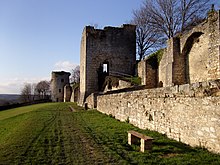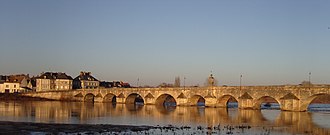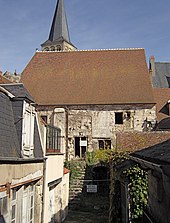La Charité-sur-Loire
| La Charité-sur-Loire | ||
|---|---|---|

|
|
|
| region | Bourgogne-Franche-Comté | |
| Department | Nièvre | |
| Arrondissement | Cosne-Cours-sur-Loire | |
| Canton | La Charité-sur-Loire (main town) | |
| Community association | Loire, Nièvre et Bertranges | |
| Coordinates | 47 ° 11 ' N , 3 ° 1' E | |
| height | 153-215 m | |
| surface | 15.78 km 2 | |
| Residents | 4,901 (January 1, 2017) | |
| Population density | 311 inhabitants / km 2 | |
| Post Code | 58400 | |
| INSEE code | 58059 | |
| Website | Ville La Charité-sur-Loire | |
 La Charité-sur-Loire |
||
La Charité-sur-Loire is a city of 4901 inhabitants (as of January 1, 2017) in France . It lies on the Loire in the department of Nièvre in the region of Bourgogne Franche-Comté . Here, about 25 kilometers north of Nevers , Route nationale 151 and Route nationale 7 intersect .
geography
Since 1861, the municipality has a railway station on the railway line Moret-Veneux-les-Sablons-Lyon-Perrache which trains of TER Bourgogne Franche-Comté the connection Cosne-sur-Loire - Nevers is operated.
history
The destruction of the Carolingian foundation of Seyr by the Saracens is reported as early as 771 . With the construction of a priory begun in 1059 by Abbot Hugo von Cluny , the city was rebuilt. In 1107 the priory church is consecrated by Pope Paschal II . The important monastery was also referred to as " Cluny's first-born daughter ". The influential priory with its impressive Romanesque church Notre-Dame and the location of La Charités on one of the four historical " Paths of the St. James pilgrims in France " promote the city's upswing. Originally the place was called Seyr, but the charitable work of the monastery resulted in the proverbial name.
In 1429 the city was besieged by Joan of Arc for a month without success . In 1559, during the Huguenot Wars , large parts of the monastery, its church and the city were destroyed by fire and in 1569 all the monks of the monastery were murdered by the Huguenots.
During the western campaign , German officers found an abandoned train in La Charité-sur-Loire on June 16, 1940, which received large parts of the secret archives of the French high command. The train had been prevented from continuing its journey by destroyed railroad tracks. The papers were less of military value than of propaganda value. For example, it became clear from the papers that there had been secret agreements between neutral Switzerland and France in the event of a German attack on Switzerland. The propaganda of the Third Reich used the papers for their own purposes.
economy
Retail still dominates in the city center, while smaller industries and retail complexes have sprung up on the “green fields”. One of the largest employers is the Center Hospitalier Spécialisé with its national psychiatry clinic . There are a good half dozen hotels as well as swimming pools and sports facilities and other establishments that benefit from tourism.
Ville du Livre
Since 2000, La Charité-sur-Loire has also been called Ville du Livre (“City of Books”). A good dozen second-hand bookshops , printing shops and a bookbindery have established themselves in the historic city center . This is an attempt to increase the city's attractiveness for visitors.
Attractions
Fortification
Although La Charité was less a place of secular power than a place of faith, it often played a strategically important role. With the permission of Philippe I , the construction of the city wall began in 1081. It encompassed the city in all four directions, including on the banks of the Loire. During the Hundred Years War , the fortifications defied the siege by Joan of Arc in 1429 and it was not until the end of the 17th century that further maintenance of the fortifications was stopped. The northern part of the walls still towers over the city and has been a listed building since 1937. Also preserved is the "Tour des Espagnols" which served as a dungeon for Spanish prisoners under Louis XIV .
Loire Bridge
In 1420 the first wooden bridge is built over the Loire. The bridge was badly damaged as early as 1520 and the prior ordered the construction of a stone bridge. The first documented stone bridge over the Loire is being built here. It consists of eleven arches. The bridge becomes a strategic point of contention in many wars. During the wars of religion - La Charité was in the hands of the Protestants at that time - two arches were destroyed for the first time in 1577. During the Second World War in 1940 an arch was blown up by the French army to stop the German advance. When the Germans flee in 1944, two more arches were blown up. The bridge was not completely restored until 1955. Today only 10 arches are visible, as the expansion of the bank reinforcement has made one arch disappear over time. In the middle of the bridge is a baroque pyramid, crowned by a ball, which shows the royal lilies . During the revolution , the sphere was destroyed and the human rights declaration was placed on the pyramid . Only recently has the ball been restored and attached thanks to a private donor.
Notre Dame
The Clunyacens priory church Notre-Dame de La Charité , built between 1059 and 1107, is a milestone in the structural development of Cluny III . The inauguration took place in the presence of Pope Paschal II.
Initially, one entered the 122-meter-long and 37-meter-wide five-aisled nave through one of the five portals of the main facade, which is equipped with two towers. After crossing the nave, you reached the seven-part transept and stood in front of the staggered choir with its large main apse and the three side apses on each side. The transept is crowned by an octagonal crossing tower .
In the second half of the twelfth century, the three central apses were replaced by an ambulatory choir with five wreath chapels . This construction also corresponded to the now completed Cluny III. In 1204 the southern facade tower collapsed into the nave and a little later parts of the northern aisle were converted into the town's parish church .
In the middle of the 16th century the nave was badly damaged by fire and it was not until 1695 that the four eastern bays were rebuilt. After the abbey was dissolved in 1790, Notre-Dame became a parish church and the former parish church became residential buildings. In 1840 Prosper Mérimée classified the monastery complex as a historical monument and thus prevented it from being demolished. In 1998, the Church of Notre-Dame , in a larger context, was declared a World Heritage Site.
Salt storage
The building was built in the 12th century as a shelter for pilgrims from the monastery. From 1642 the complex served as a hospital. After the new hospital could be used in 1690, the house was converted into a salt storage facility. The building has been empty for a long time and is falling into disrepair. In addition to its enchanted exterior, the salt store impresses with its Romanesque architectural sculpture.
city Museum
The city museum was established in 1954 by a foundation in a town house inherited from the city. It shows archaeological finds on several levels that document monastery life and the beginnings of the city, as well as arts and crafts of Art Nouveau and Art Deco . René Lalique , Emile Gallé and Daum Frères , among others, are represented with exhibits .
Twin cities
- Biedenkopf an der Lahn (Germany), since 1960
- Neustadt an der Orla (Germany), since 2001
- Wépion sur Meuse (Belgium), since 1964.
- Oostduinkerke aan Zee (Belgium), since 1972.
- Castiglion Fiorentino (Italy), since 2004
literature
- Le Patrimoine des Communes de la Nièvre. Volume 1, Flohic Editions, Charenton-le-Pont 1999, ISBN 2-84234-054-X , pp. 105-121.
Individual evidence
- ↑ Pierre Beaussart: L'Eglise Bénédictine de La Charité-sur-Loire. 'fille ainée de Cluny'. Delayance, La Charité sur Loire, 1929.
- ^ Thorsten Droste: Burgundy: Monasteries, castles, historical cities and the culture of viticulture in the heart of France . DuMont Reiseverlag, Cologne, 1998, ISBN 978-3-7701-4166-1 .
- ^ Henri Koch-Kent: A PROPOS DES ARCHIVES SECRETES FRANÇAISES TOMBEES AUX MAINS DES ALLEMANDS EN GARE DE LA CHARITE-SUR-LOIRE. Anciens des Services Spéciaux de la Défense Nationale (France), accessed on June 19, 2018 (French).
Web links
- City tourist information (German)






